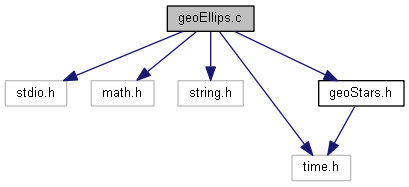 |
Geo Stars Library
0.9.3
Geodetic and Astrometry library
|
 |
Geo Stars Library
0.9.3
Geodetic and Astrometry library
|
This file contains geo library location setup and initialization of ellipsoid values. There are 23 ellipsoids to choose from, of which the WGS 84 ellipsoid is the default ellipsoid. More...

Go to the source code of this file.
Functions | |
| int | geoInitLocation (GEO_LOCATION *l, double lat, double lon, double hgt, int datum, char *name) |
| This routine needs to be called when a site (or location) is initialized. Several of the routines use the information in the structure that this routine fills. More... | |
| void | geoSetTimeZone (GEO_LOCATION *l, double tz, int dst) |
| void | geoGetEllipsoid (double *a, double *b, double *e2, double *ee2, double *f, int datum) |
| This routine computes essential datum values from basic parameters obtained from the ellips structure. More... | |
Variables | |
| GEO_ELLIPSOID | ellips [] |
| This structure array contains the all of the ellipsoids used in this library. More... | |
This file contains geo library location setup and initialization of ellipsoid values. There are 23 ellipsoids to choose from, of which the WGS 84 ellipsoid is the default ellipsoid.
Definition in file geoEllips.c.
| void geoGetEllipsoid | ( | double * | a, |
| double * | b, | ||
| double * | e2, | ||
| double * | ee2, | ||
| double * | f, | ||
| int | datum | ||
| ) |
This routine computes essential datum values from basic parameters obtained from the ellips structure.
| double | *a : Major axis ( Meters ) |
| double | *b : Minor axis ( Meters ) |
| double | *e2 : Eccentricity |
| double | *ee2 : Eccentricity prime |
| double | *f : Flattening |
| int | datum : Datum to use |
Definition at line 189 of file geoEllips.c.
References GEO_ELLIPSOID::a, GEO_B, GEO_E2, GEO_E2P, and GEO_FL.
Referenced by geoEfg2Llh(), geoEfg2Llh_aa(), geoEfg2Llh_borkowski(), geoEfg2Llh_bowring(), geoEfg2Llh_heikkinen(), geoEfg2Llh_hm(), geoEfg2Llh_toms(), geoEfg2Llh_torge(), geoEfg2Llh_vermeille(), geoInitLocation(), and geoLlh2Efg().
| int geoInitLocation | ( | GEO_LOCATION * | l, |
| double | lat, | ||
| double | lon, | ||
| double | hgt, | ||
| int | datum, | ||
| char * | name | ||
| ) |
This routine needs to be called when a site (or location) is initialized. Several of the routines use the information in the structure that this routine fills.
| GEO_LOCATION | *l |
| double | lat |
| double | lon |
| double | hgt |
| int | datum |
| char | *name //Name of the site location |
| GEO_OK | on success |
| GEO_ERROR | on error |
Definition at line 96 of file geoEllips.c.
References GEO_DATUM::a, GEO_DATUM::b, GEO_LOCATION::clat, GEO_LOCATION::clon, GEO_LOCATION::clonclat, GEO_LOCATION::clonslat, GEO_LOCATION::datum, GEO_DATUM::datum_num, DEG_TO_RAD, GEO_LOCATION::e, GEO_DATUM::e2, GEO_DATUM::ee2, GEO_LOCATION::efg, GEO_LOCATION::f, GEO_DATUM::flat, GEO_LOCATION::g, GEO_DATUM_MAX, GEO_E, GEO_ERROR, GEO_F, GEO_G, GEO_OK, geoGetEllipsoid(), geoMagFillDec(), GEO_LOCATION::hgt, GEO_LOCATION::lat, GEO_LOCATION::lon, GEO_DATUM::m1e2, GEO_LOCATION::name, GEO_LOCATION::rlat, GEO_LOCATION::rlon, GEO_LOCATION::slat, GEO_LOCATION::slon, GEO_LOCATION::slonclat, GEO_LOCATION::slonslat, GEO_LOCATION::timezone, and GEO_LOCATION::tlat.
Referenced by geoLlh2DiffX(), geoLlh2DiffY(), geoLlh2DiffZ(), geoLlh2E(), geoLlh2F(), geoLlh2G(), geoSunNowAz(), and geoSunNowEl().

| void geoSetTimeZone | ( | GEO_LOCATION * | l, |
| double | tz, | ||
| int | dst | ||
| ) |
Definition at line 169 of file geoEllips.c.
References GEO_LOCATION::dst, and GEO_LOCATION::timezone.
| GEO_ELLIPSOID ellips[] |
This structure array contains the all of the ellipsoids used in this library.
Definition at line 46 of file geoEllips.c.
Referenced by geomg1().
 1.8.4
1.8.4